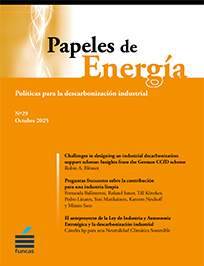Políticas para la descarbonización industrial
Fecha: 2025
Papeles de Energía, N.º 29 (octubre 2025)
Sumario
To support industrial transformation towards climate neutrality, Germany has developed a Carbon Contract for Differences (CCfD) support scheme. The scheme aims to complement the carbon pricing of the EU ETS by subsidizing and de-risking innovative decarbonization technologies in industry. It can become a cornerstone in the German competitiveness and a transformation strategy of the manufacturing sector. The design of the scheme drew inspiration from other support schemes and scientific literature. It is implemented as a two-sided CCfD, with an indexed strike price. Overall, the scheme is rather complex for multiple reasons.
Firstly, it covers different sectors with a technology open design. Secondly, the support is allocated in a multitechnology auction, with possibilities for sectoral and technological differentiation. And thirdly, it aims to not only de-risk projects for carbon prices but also energy prices, while giving projects incentives to use and procure energy efficiently.
The first support round attracted a lot of interest from projects in its pre-phase, but the 4-billion-euros auction round was undersubscribed. The analysis of the first auction round provides valuable insights on decarbonization technologies and how advanced projects in each sector are. The primary objective of adjustments should be to ensure competition in the support auction and reduce complexity. The second support round was delayed, and further rounds are uncertain due to changes in government. Besides Germany, other countries and the European Commission are developing support schemes that use some form of CCfDs, highlighting the relevance and need for further investigation of CCfD design and auction outcomes.
La Contribución para una Industria Limpia (Clean Industry Contribution o CIC) es un impuesto que grava la producción o importación de materiales básicos con altas emisiones, como el acero, el cemento o el aluminio, independientemente de su ubicación y método de producción. Su objetivo es complementar el Sistema europeo de comercio de emisiones (EU ETS) y el mecanismo europeo de ajuste en frontera (CBAM) para que la estrategia de descarbonización industrial europea sea resistente a la incertidumbre política internacional en un mundo fragmentado.
En este documento abordamos las principales cuestiones relativas a la CIC, combinando las conclusiones de los primeros análisis de la “Plataforma de Materiales Respetuosos con el Clima”, el estudio de apoyo de la DG TaxUd sobre la aplicación del CBAM y una publicación reciente de un consorcio de investigación mundial sobre la contribución al clima.
Este trabajo presenta el resumen del foro de diálogo organizado por la Cátedra bp para una Neutralidad Climática Sostenible de la Universidad Pontificia Comillas acerca del anteproyecto de la Ley de Industria y Autonomía Estratégica. El foro tuvo lugar en noviembre de 2024, y en él participaron unos 20 representantes académicos, institucionales, y del mundo empresarial. La reunión se celebró a puerta cerrada, regida por la regla Chatham House (se puede citar lo que se ha discutido, pero no quién).

